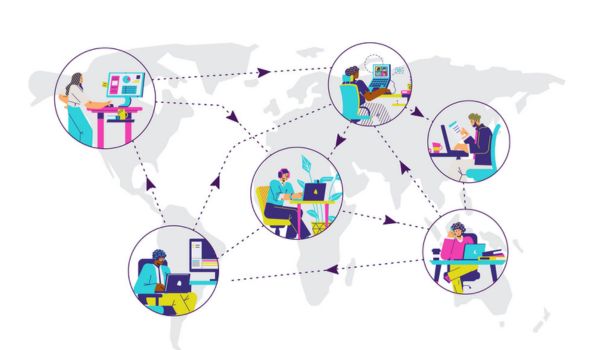
Offshore outsourcing is a strategic approach that many businesses use to stay competitive by reducing costs and accessing global talent. However, despite its benefits, offshore outsourcing presents various challenges that companies must navigate effectively. Below, we will explore the Overcoming Challenges in Offshore Outsourcing and practical solutions to overcome them. Understanding these challenges in depth and employing targeted solutions can greatly enhance the outcomes of offshore outsourcing strategies.
1. Communication Barriers, Overcoming Challenges in Offshore Outsourcing

Language and time zone differences can create communication gaps, leading to misunderstandings and project delays. These gaps can escalate into larger issues if not addressed promptly, impacting overall productivity and trust.
Solution: To bridge communication barriers, establish clear communication protocols and utilize collaboration tools like Slack, Zoom, or Microsoft Teams. Regularly scheduled meetings and updates can ensure all parties are on the same page. Investing in language training for teams or hiring bilingual staff can also significantly reduce miscommunication. Additionally, create documentation for key processes and terminology guides to standardize communication and minimize misunderstandings. Encouraging the use of clear and concise language, along with visual aids, can enhance understanding during virtual meetings.
Ensuring that both onshore and offshore teams are aware of cultural nuances related to communication styles can also improve interactions. For example, some cultures may be more direct in their feedback, while others may be more reserved. Addressing these differences openly can foster a respectful and adaptive communication environment. Implementing a communication matrix that outlines who to contact for specific issues can reduce confusion and speed up response times.
2. Cultural Differences, Overcoming Challenges in Offshore Outsourcing

Different cultural norms can impact work styles, expectations, and interactions, sometimes leading to friction between onshore and offshore teams. Differences in business etiquette, problem-solving approaches, and communication styles can affect collaboration.
Solution: Promote cultural awareness through training and team-building activities that encourage mutual respect and understanding. Recognize and celebrate cultural differences as strengths. Clear documentation of work processes and company expectations can help set a standard that everyone follows. Implement mentorship programs that pair onshore and offshore team members to build strong interpersonal connections and improve cultural integration.
Organizing cross-cultural workshops can help team members learn about each other’s traditions, holidays, and work habits. This not only enhances team cohesion but also helps to avoid potential misunderstandings. Creating shared virtual spaces where teams can engage in informal conversations, like watercooler chats or team bonding activities, can strengthen relationships. Leaders should emphasize inclusive practices and celebrate milestones together to maintain morale.
3. Time Zone Challenges, Overcoming Challenges in Offshore Outsourcing

When teams are spread across various time zones, it can be difficult to find overlapping working hours for collaboration. This can result in delays in decision-making and hinder project momentum.
Solution: Implement a ‘follow the sun’ model to maintain productivity around the clock. Ensure that project management tools like Trello, Asana, or Jira are used for task tracking. Schedule meetings during overlapping hours and employ asynchronous communication to keep progress moving forward. Designate specific team members to act as points of contact during different shifts to ensure seamless communication throughout the day.
Using shared calendars and time zone converters can make scheduling easier for both onshore and offshore teams. It is also beneficial to record meetings and share them with team members who could not attend due to time zone constraints. This way, everyone can stay informed and contribute effectively. Encouraging flexible work hours for overlapping shifts can make collaboration smoother and more inclusive.
Establishing clear handoff procedures when transitioning work between time zones is crucial for maintaining momentum. Detailed documentation and end-of-day summaries can provide context for the incoming team, preventing productivity loss.
4. Quality Control Issues
Ensuring consistent quality can be challenging when work is outsourced to an offshore team with different standards. Variations in skill levels, training backgrounds, and project management practices can all contribute to quality discrepancies.
Solution: Define clear quality benchmarks and standards in the initial project documentation. Conduct regular quality audits and establish a robust feedback loop for continuous improvement. Incorporating detailed training and onboarding programs for offshore teams can align their output with company expectations. Encourage offshore teams to adopt best practices and conduct peer reviews to maintain a high standard of work. Employ quality assurance (QA) tools to automate parts of the review process for faster feedback.
Engaging in pilot projects with offshore teams before fully committing to large-scale tasks can help assess their capabilities and iron out quality concerns early on. Assigning a dedicated quality assurance manager who oversees the work from both sides ensures consistent adherence to quality metrics. Implementing a dual-review system where both onshore and offshore team members review the work can also help in maintaining quality standards.
5. Data Security Concerns
Offshore outsourcing can expose companies to data security risks, including potential breaches and compliance violations. Different countries have varying regulations and levels of data protection, adding complexity to maintaining security.
Solution: Prioritize data security by implementing strict data protection protocols. Use secure communication channels and require offshore partners to comply with international data security standards such as GDPR. Regular security audits and the use of Virtual Private Networks (VPNs) can bolster data protection efforts. Draft comprehensive data protection agreements (DPAs) that outline how data should be handled and shared. Employ encryption tools and secure access controls to protect sensitive information.
Collaborating with offshore teams to establish a shared security policy can enhance compliance. Train offshore staff on the importance of data protection and best practices. Using endpoint protection software and data loss prevention (DLP) tools can help safeguard sensitive information from potential threats. Partnering with cybersecurity experts to monitor systems and implement patches regularly ensures that security standards are up to date.
6. Dependency on Third-Party Providers
Relying heavily on offshore partners can lead to issues if the partner faces operational challenges or service disruptions. This dependency can create vulnerabilities in the business model.
Solution: Mitigate risks by diversifying your outsourcing portfolio. Avoid putting all your business-critical tasks into one provider’s hands. Establish backup plans and maintain a flexible contract structure that allows for quick pivots if necessary. Develop an in-house contingency team capable of taking over critical tasks in the event of a provider’s failure. Regularly evaluate the reliability of your offshore partners through performance metrics and customer reviews.
Building long-term relationships with multiple partners across different regions can spread the risk and ensure business continuity. Contracts should include service-level agreements (SLAs) that clearly define performance expectations and penalties for non-compliance. Continuous collaboration with multiple providers also fosters healthy competition, ensuring higher service standards. Regularly updating business continuity plans based on risk assessments can prepare companies for unforeseen disruptions.
7. Project Management Complexities
Managing a project that spans multiple locations and teams can be complex and time-consuming. Different work methodologies and varying levels of project management expertise can make coordination difficult.
Solution: Employ experienced project managers who understand both onshore and offshore dynamics. Use comprehensive project management software to keep everyone aligned. Regular status checks, clear timelines, and assigning local coordinators on both sides can simplify project management and enhance accountability. Implement agile practices to allow for adaptive planning and frequent reassessments. Creating clear task ownership and a hierarchy of responsibilities can ensure better coordination.
Investing in advanced training for project managers to handle multicultural teams can improve project outcomes. Leveraging real-time dashboards that show project progress can make it easier to monitor the work of distributed teams. Establishing clear escalation protocols ensures that potential issues are addressed swiftly and efficiently. Regular retrospective meetings can help teams reflect on their processes and identify areas for improvement.
8. Legal and Compliance Issues
Outsourcing to other countries can introduce legal challenges related to labor laws, intellectual property rights, and industry regulations. Companies may face different legal landscapes that complicate contractual agreements.
Solution: Work with legal experts who specialize in international business to navigate the regulatory landscape. Ensure that contracts are watertight and cover essential elements such as IP rights and non-disclosure agreements (NDAs). Staying updated on local laws in the outsourcing country can prevent legal disputes. Implement regular compliance checks and involve legal teams during contract revisions. Educating your offshore team on applicable compliance standards and practices can also help mitigate legal risks.
Partnering with local law firms in the offshore location can provide deeper insights into regional regulations. Creating detailed compliance checklists for specific industries ensures that both onshore and offshore teams meet legal requirements. Keeping a record of all agreements, audits, and communications is essential for demonstrating compliance in case of disputes. Regular training for legal and compliance teams helps them stay current with changing regulations and adjust strategies as needed.
9. Employee Morale and Retention
Outsourcing certain roles can impact onshore employees’ morale, leading to concerns about job security and retention. When employees feel threatened by outsourcing, it can affect productivity and workplace culture.
Solution: Maintain transparency about the reasons for outsourcing and how it benefits the overall business. Highlight opportunities for growth within the company, such as upskilling or leadership roles. Foster a collaborative environment where onshore and offshore teams feel like a unified group working toward shared goals. Regularly communicate the value of each team’s contributions and create initiatives that involve both onshore and offshore teams in joint problem-solving and decision-making.
Organizing workshops and training programs for onshore employees can showcase how outsourcing can complement their work rather than replace it. Encouraging cross-team mentorship opportunities can also strengthen bonds and reduce competition. Recognize and reward contributions from all teams, whether onshore or offshore, to maintain a positive and inclusive work culture. Providing employees with clear career paths and